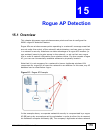
Chapter 15 Rogue AP Detection
NWA-3500/NWA-3550 User’s Guide
181
that of a neighbor (for example) you should also add these APs to the list, as they
do not compromise your own network’s security. If you do not add them to the
friendly AP list, these access points will appear in the Rogue AP list each time the
NWA scans.
“Honeypot” Attack
Rogue APs need not be connected to the legitimate network to pose a severe
security threat. In the following example, an attacker (X) is stationed in a vehicle
outside a company building, using a rogue access point equipped with a powerful
antenna. By mimicking a legitimate (company network) AP, the attacker tries to
capture usernames, passwords, and other sensitive information from
unsuspecting clients (A and B) who attempt to connect. This is known as a
“honeypot” attack.
Figure 114 “Honeypot” Attack
If a rogue AP in this scenario has sufficient power and is broadcasting the correct
SSID (Service Set IDentifier) clients have no way of knowing that they are not
associating with a legitimate company AP. The attacker can forward network traffic
from associated clients to a legitimate AP, creating the impression of normal
service. This is a variety of “man-in-the-middle” attack.
This scenario can also be part of a wireless denial of service (DoS) attack, in which
associated wireless clients are deprived of network access. Other opportunities for
the attacker include the introduction of malware (malicious software) into the
network.


















